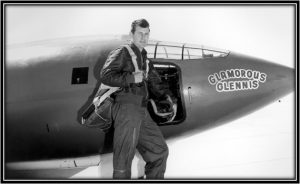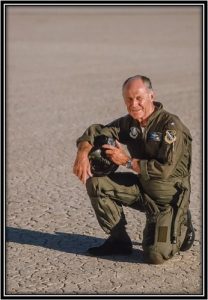Glamorous Glennis
Contributor: Barry Fetzer
Sources: History.com
Breaking the speed of sound was a real milestone—and a risky one too. If you ever watched the Twilight Zone TV show, several episodes dealt with the fear of what could happen should humans continue to achieve such speeds, including disappearing for a while, perhaps in alien captivity, and time travel. Our burgeoning post WW-2 technologies and quest for space flight fueled our fears as demonstrated by the Twilight Zone. But none of those fears were realized. On this day in 1947, U.S. Air Force Captain Chuck Yeager was the first person to fly faster than the speed of sound.
From History.com: “Yeager, born in Myra, West Virginia, in 1923, was a combat fighter during World War II and flew 64 missions over Europe. He shot down 13 German planes and was himself shot down over France, but he escaped capture with the assistance of the French Underground. After the war, he was among several volunteers chosen to test-fly the experimental X-1 rocket plane, built by the Bell Aircraft Company to explore the possibility of supersonic flight.

Yeager with Glamorous Glennis, 1947. Photo Credit: USAF
“For years, many aviators believed that man was not meant to fly faster than the speed of sound, theorizing that transonic drag rise would tear any aircraft apart. All that changed on October 14, 1947, when Yeager flew the X-1 over Rogers Dry Lake in Southern California. The X-1 was lifted to an altitude of 25,000 feet by a B-29 aircraft and then released through the bomb bay, rocketing to 40,000 feet and exceeding 662 miles per hour (the sound barrier at that altitude). The rocket plane, nicknamed Glamorous Glennis (after Yeager’s wife), was designed with thin, unswept wings and a streamlined fuselage modeled after a .50-caliber bullet.
“Reports of the flight leaked to the press in December 1947, but because of the secrecy of the project, Bell and Yeager’s achievement was not officially confirmed until June 1948. Yeager continued to serve as a test pilot, and in 1953 he flew 1,650 miles per hour in an X-1A rocket plane. He retired from the U.S. Air Force in 1975 with the rank of brigadier general. Yeager died on December 7, 2020, at age 97.”

Yeager later in life. Photo Credit: Getty Images
While Yeager apparently never flew the X-15 itself, the follow-on aircraft to its predecessor X-1, Yeager did serve in the X-15 program as an NB-52 (the modified B-52 “mother ship” for the X-15) co-pilot for an aborted X-15 flight.

The X-15. Photo Credit: Wikipedia







